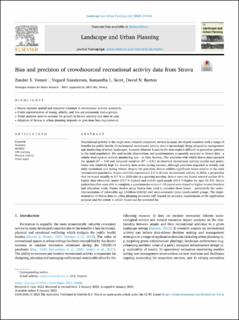Bias and precision of crowdsourced recreational activity data from Strava
Peer reviewed, Journal article
Published version

Åpne
Permanent lenke
https://hdl.handle.net/11250/3091374Utgivelsesdato
2023Metadata
Vis full innførselSamlinger
- Publikasjoner fra CRIStin - NINA [2364]
- Scientific publications [1392]
Originalversjon
10.1016/j.landurbplan.2023.104686Sammendrag
Recreational activity is the single most valuable ecosystem service in many developed countries with a range of benefits for public health. Crowdsourced recreational activity data is increasingly being adopted in management and monitoring of urban landscapes, however inherent biases in the data make it difficult to generalize patterns to the total population. We used in-situ observations and questionnaires to quantify accuracy in Strava data - a widely used outdoor activity monitoring app – in Oslo, Norway. The precision with which Strava data captured the spatial (R2 = 0.9) and temporal variation (R2 = 0.51) in observed recreational activity (cyclist and pedestrian) was relatively high for monthly time series during summer, although precision degraded at weekly and daily resolutions and during winter. Despite the precision, Strava exhibits significant biases relative to the total recreationist population. Strava activities represented 2.5 % of total recreationist activity in 2016, a proportion that increased steadily to 5.7 % in 2020 due to a growing usership. Strava users are biased toward cyclists (8 % higher than observed), males (15.7 % higher) and middle-aged people (20.4 % higher for ages 35–54). Strava pedestrians that were able to complete a questionnaire survey (>19 years) were biased to higher income brackets and education levels. Future studies using Strava data need to consider these biases – particularly the underrepresentation of vulnerable age (children/elderly) and socio-economic (poor/uneducated) groups. The implementation of Strava data in urban planning processes will depend on accuracy requirements of the application purpose and the extent to which biases can be corrected for. Accuracy Mobility GPS tracking Physical activity Green space
